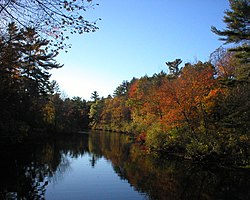| Ipswich River | |
|---|---|
 | |
| Location | |
| Country | United States |
| Physical characteristics | |
| Source | |
| • location | Burlington, Massachusetts |
| • coordinates | 42°33′14″N 71°08′38″W / 42.5539828°N 71.1439441°W |
| Mouth | |
• location | Ipswich Bay, Massachusetts |
• coordinates | 42°41′38″N 70°47′23″W / 42.6939825°N 70.7897712°W |
• elevation | 0 ft |
| Length | 35 mi (56 km) |
| Basin size | 155 sq mi (400 km2) |
| Basin features | |
| Tributaries | |
| • left | Skug River, Boston Brook |
| • right | Miles River, Salem Beverly Waterway Canal |
Ipswich River is a small river in northeastern Massachusetts, United States. It held significant importance in early colonial migrations inland from the ocean port of Ipswich. The river provided safe harborage at offshore Plum Island Sound to early Massachusetts subsistence farmers, who were also fishermen. A part of the river forms town boundaries and divides Essex County, Massachusetts on the coast from the more inland Middlesex County.[1] It is 35 miles (56 km) long,[2] and its watershed is approximately 155 square miles (401 km2), with an estimated population in the area of 160,000 people.[3]
Historically, the settlement of Essex County began at the oldest community there, the tiny seaport of Agawam (later renamed Ipswich, and not to be confused with present-day Agawam in Hampden County), and typically proceeded westward and northward along the Ipswich or its tributary creeks. When Middlesex County was formed in the Massachusetts Bay Colony, only Salem and Charlestown across the Charles River mouth and Boston harbor's inner estuary from Boston's much smaller hill dominated peninsula were older settlements.
The upper river runs through and drains at least parts of Burlington, the lower river forms part of the borders between the towns of:
- North Reading and Lynnfield
- Middleton and the city of Peabody
- Middleton and Danvers, and
- Boxford and Topsfield.
The wide swamps along the river made it impossible to ford the stream anywhere east of Wilmington in colonial times. The only route north out of Boston to the northeast (today called the North Shore) was via the Andover Road, an often muddy track, later made a wagon road which forded the stream just below the confluence of Lubbers and Maple Meadow brooks.
- ^ U.S. Geological Survey Geographic Names Information System: Ipswich River
- ^ "The National Map - National Hydrography Dataset high-resolution flow line data". viewer.nationalmap.gov. United States Geological Survey. Archived from the original on 2012-03-29. Retrieved 1 Apr 2011.
- ^ "Ipswich River Watershed". mass.gov. Massachusetts Executive Office of Environmental Affairs. Archived from the original on 29 September 2007. Retrieved 8 Jan 2017.